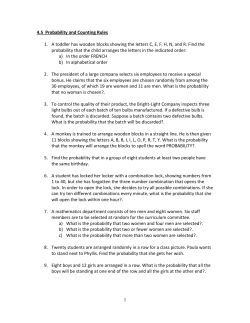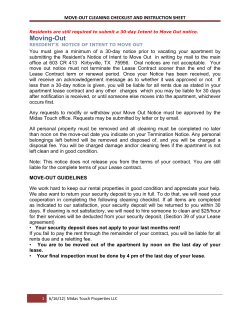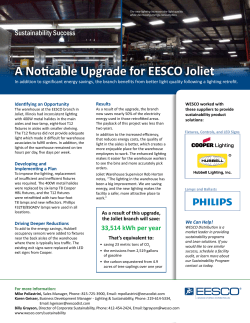
A Fluorescent lighting: Function, energy use, cost, and safety
f e at u r e Fluorescent lighting: Function, energy use, cost, and safety A re you using fluorescent lighting in your facility? You may already use the long fluorescent tubes in ceiling fixtures, but what about the curled bulbs advocated for replacing incandescent bulbs? These curled lights are called compact fluorescent lights, or simply CFLs. Here’s a quick look at function, energy use, cost, and safety. Function Good lighting is important in child care and education. Well-lit rooms set the tone for care and learning activities. Soft, dimmed lighting helps calm children at nap time. Adequate lighting is especially important in spaces where children and adults need to see tiny things, such as print and pictures in books, puzzle pieces and other manipulatives, and items for observation and study in science activities. The quality of light produced by fluorescent compared to incandescent light is up for debate. The current generation of CFLs, for example, has been criticized for the way color looks under its light and the limited number of models that can be dimmed. At least one expert (Vestel 2009) suggests these shortHow does it work? Fluorescent and incandescent bulbs produce light in different ways. An incandescent bulb creates light by using electricity to heat a filament inside a bulb. The filament becomes white hot, producing light. A fluorescent bulb, on the other hand, uses electricity to excite a gas that produces ultraviolent light. Ordinarily, we can’t see UV light, but in a fluorescent bulb, the UV light strikes the white phosphor coating inside the tubes, causing it to fluoresce or produce light we can see. comings have resulted from manufacturers’ compromising CFL quality to achieve the lower purchase price that consumers demand. well-lit rooms set the tone for care and learning activities. Fluorescent bulbs can replace incandescent bulbs in many lighting situations. However, fluorescent bulbs are not advised for a totally enclosed fixture, such as a recessed can light; vibrating fixtures, such as garage door openers and some ceiling fans; and electronically controlled timers and sensors. Energy use Because incandescent bulbs are actually little heaters that create light, they use more energy than fluorescent bulbs. According to the U.S. Environmental Protection Agency, the best fluorescent bulbs use about 75 percent less energy than traditional incandescent bulbs. What’s more, fluorescent bulbs can last up to 10 times longer than incandescent bulbs. That means we buy fewer of them, and fewer used bulbs end up in our landfills. For optimum operation, however, fluorescent lights need to be left on for at least 15 minutes at a time. Switching them off and on can shorten their life and decrease their energy saving benefits. Important: ENERGY STAR-rated CFLs have a two-year warranty. If the bulb fails within the warranty period, return it to your retailer. As with other purchases, it’s wise to save receipts. To encourage the use of more energy efficient © Texas Child Care quarterly / fall 2011 / VOLUME 35, NO. 2 / childcarequarterly.com lighting, President George W. Bush signed a bill in 2007 that set a timetable for replacing standard light bulbs on store shelves with ones that use 30 percent less energy. The timetable starts with 100-watt bulbs in January 2012 and cycles through other sizes, ending with 40-watt bulbs in January 2014. A second tier, requiring all bulbs sold to be at least 60-70 percent more energy efficient (like today’s CFLs) would go into effect by 2020. A common misconception is that the law forces us to use CFLs. Not quite. It says only that lights be 30 percent more energy efficient. It’s possible, for example, that manufacturers will develop better performing incandescent lights and that other technologies such as halogen and light-emitting-diodes (LEDs) could meet the standard. In addition, many types of incandescent bulbs, including refrigerator lights and three-way bulbs, are exempt from the law. Furthermore, the law does not require bulbs be replaced in homes and businesses but only that more efficient lights be sold in stores. Cost The cost of lighting involves several factors, including the bulb’s wattage, purchase price, operating cost, and longevity. Watts, the measurement of the speed of energy flow, is lower in a CFL than in an incandescent bulb and still produces a similar level of light. Hence, the chart below compares a 25-watt CFL to a 100-watt incandescent. The cost to operate is based on usage of six hours a day and a utility charge of 11.3 cents a kilowatt-hour. Comparing CFL to Wattage Lamp price Annual energy cost Longevity incandescent 25-watt CFL 100-watt incandescent $3.40 60 cents $6 $25 1,667 days 167 days Source: www.energysavers.gov In the example above, using a fluorescent bulb would save $19 a year in electricity cost, not counting the cost of replacing an incandescent bulb every six months nor the higher cost of a higher watt bulb. And this savings applies to just one bulb. To calculate potential savings for your facility, see the Savings Calculator on the ENERGY STAR website. Safety Fluorescent bulbs pose a safety threat not found in incandescent bulbs. The gas used in fluorescents is mercury, a toxic element that can damage the brain, kidney, and lungs and impair the development of the brain and nervous system in children and babies developing in the womb. Fluorescent bulbs pose a safety threat not found in incandescent bulbs. The amount of mercury is small, an average of 5 milligrams, or roughly the tip of a ballpoint pen. By contrast, old home thermostats contain a hundred times that much. CFLs pose no hazard when used properly. If a CFL breaks, however, mercury vapor can escape. If that happens, the EPA recommends the following: ■ Have everyone leave the room immediately. ■ Open windows or doors to ventilate the room for 10 to 15 minutes before returning to clean it up. ■ Turn off the central heating and air for several hours. ■ Sweep up the broken pieces and visible powder. Little bulbs, big impact The U.S. Environmental Protection Agency and the U.S. Department of Energy have jointly developed the ENERGY STAR Program, which sets energy efficiency criteria for consumer products, including light bulbs. What difference does it make? If every American home replaced just one light with an ENERGY STAR bulb, we would save enough energy to ■ light 3 million homes for a year, ■ save about $600 million in annual energy costs, and ■ prevent 9 billion pounds of greenhouse gas emissions a year, which is roughly equivalent to emissions from 80,000 cars. Source: www.energystar.gov © Texas Child Care quarterly / fall 2011 / VOLUME 35, NO. 2 / childcarequarterly.com Don’t vacuum. Use protective gloves and a damp paper towel or bar of soap to pick up the pieces. You will be at greater risk if you get cut by broken shards. ■ Place bulb pieces and clean-up materials in two sealed plastic bags. ■ Discard properly. When a CFL wears out, recycle it so that the mercury may be reused. Some states and localities require recycling and prohibit dumping any fluorescent lights into trash headed for the landfill. Two options: ■ Visit www.earth911.com, an environmental services company that enables you to find recycling centers by ZIP code. Or call 1-800-CLEANUP. Home improvement stores, such as Lowe’s and Home Depot, will often accept used CFLs. ■ Call your local waste management agency for instructions. If your disposal service incinerates trash, seek another option. CFLs should not be burned. Take the same care in handling and disposing of long fluorescent tubes. Do not break the tubes to fit into a container, and recycle them if possible. A final note: The UV light emitted by fluorescent bulbs is less than that from natural sunlight and not enough to be hazardous. Remember that CFLs, like many common products, may pose hazards to children and adults. Read CFL labels carefully to choose the right size and appropriate use of bulbs. Educate staff and parents about proper handling and disposal of all fluorescent light bulbs. References GE Lighting. “Compact Fluorescent Light Bulbs (CFL): FAQs.” www.gelighting.com. U.S. Department of Energy. “How Compact Fluorescents Compare with Incandescents.” www. energysavers.com. U.S. Department of Energy and U.S. Environmental Protection Agency. “Light Bulbs (CFLs) for Consumers.” www.energystar.gov. U.S. Environmental Protection Agency. “Compact Fluorescent Light Bulbs (CFLs).” www.epa.gov/ cfl/. Vestel, Leora Broydo. Jan. 27, 2009. “Why Efficient Light Bulbs Fail to Thrive,” in “Green,” a New York Times blog. http://green.blogs.nytimes. com/2009/01/27/. n Summary CFLs are most cost efficient and effective in rooms where lights are left on for long periods, such as classrooms, but less so in short-term-use areas such as closets and pantries. Because fluorescents need to be changed less often, they are better for high, hardto-reach ceilings, such as gymnasiums. Store and use CFLs properly Because breaking a CFL poses a hazard, it’s imperative to store and use fluorescent bulbs properly. ■ Handle CFLs carefully when buying and transporting them. ■ Store CFLs on a high shelf or locked cabinet out of children’s reach. ■ Avoid rough handling when dusting or cleaning light fixtures containing CFLs. ■ Position lamps with CFLs in places where children and adults will not easily bump into them. © Texas Child Care quarterly / fall 2011 / VOLUME 35, NO. 2 / childcarequarterly.com
© Copyright 2025





















